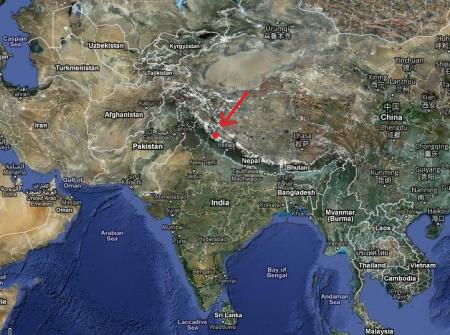
Location of the Mana village on the map
Mana village is the last village on the Indo – Tibetan border in the state of Uttaranchal. It is situated at a height at of 3,219 meters, 4 km nortwest from Badrinath.

Mana village
The villagers of Mana are semi-nomads who escaped Tibet during the Chinese occupation.
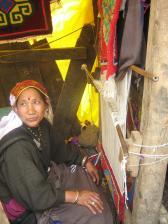
Village women
Altough being more Tibetans than Indians they are strongly connected to Hindu culture and heritage. Every year the girls and women of the village make woolen shawls for the deity of Badrinarayan in Badrinath. The shawls are offered to the deity on the Temple closing ceremony at the beginning of the winter season.
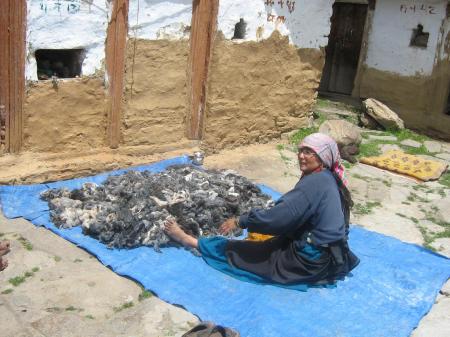
Making woolen shawls
Mana village is full of caves and it is believed that Vyasa composed his famous epic, the Mahabharata, in one of the caves. The rocks on the cave look like layers of paper and are said to represent Mahabharata. Inside the cave there is an idol of Vyasadev and a priest who recites Mahabharata.

Vyasa's cave
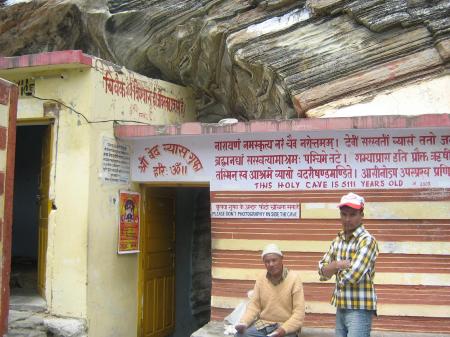
Entrance to the cave
Nearby is also another cave called Ganesh’s cave where it is said that Ganesh wrote down Mahabharata while Vyasa narrated the story.
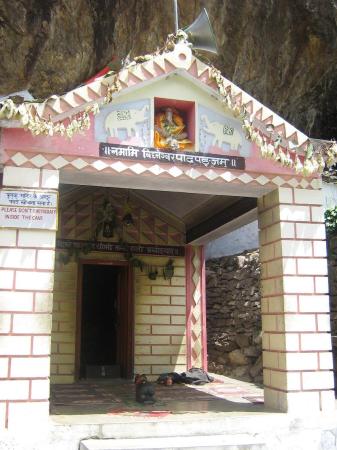
Ganesh's cave
It is believed that the village was visited by Pandavas on their way to Heaven, after renouncing their kingdom. At the end of the village there is a bridge called Bhima Pul (Bhima’s bridge) which Bhima is said to have made from a huge stone rock, so his brothers and Draupadi could cross the Sarasvati river safely.

Bhima's bridge
After leaving Mana Pandava’s continued their journey through a meadow full of flowers before reaching the Vasudhara Falls. I would recommend this place to everyone with a quote: “Never lose an opportunity to see anything that is beautiful. It is God’s handwiting – a wayside sacrament.”

Beyond Mana

On the way to Vasudhara falls
From Vasudhara the trail leads to the Lakshmivan, the place where Draupadi is believed to left her body. This dense forest is about 4 km from Vasudhara. A little bit further, at Chakratirtha, Arjuna gave up his body. Beyond Mana, on the way to Vasudhara falls and further you can see many caves and sadhus who live there during the year, without clothes, without food, eating only flour mixed with water and raw potatos. If food is unavailable, they live only on sun and air. For them, the mind is a power, and when controlled and directed, its force and subtlety are apparently unlimited.

Sadhu at his cave
After walking across the Chakratirtha meadow and over the steep rise of the glacier the other Pandavas also left this world and only Yudhishtira with his dog, who was Lord Dharma himself, reached Satopanth valley (4, 402 m) where he ascended to the Heaven at the foot of Svargarohan Mountain (7, 898 m).
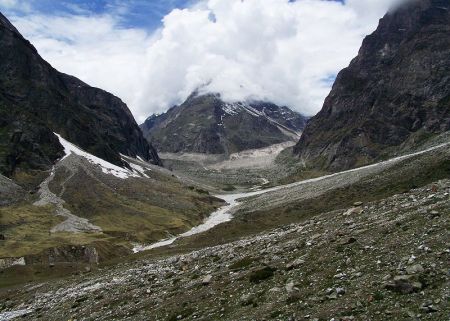
The trail of Pandavas
Satopanth valley and the lake, surrounded by innumerable lotus flowers, are about 18 km from Mana village. Climbing up and down is very dangerous so the guide must be taken for this route. Being the part of the Devbhumi, Land of the Gods, this trail will capture your attention at every step and while surrounded with the unlimited beauty of nature you will realise that the most beautiful things cannot be seen or touched, but they can be only felt within the heart.

Wow, this place looks quite incredible as well. I’ll have to keep this on my list of places to eventually see for sure!
What a fantastic post. It brings back so many memories.
I took the trail twice from Badrinath to Vasudhara. Completely incredible, the peace, beauty, simplicity, and the holy vibrations there, no words or photos can capture it. One must experience it with open hearts, that is the only way.
Manas is an adorable village with such beautiful people. What do they do with the shawls after the offering?
In the last photo, which peak is it? Any significance to it?
Hope to make it beyond Vasudhara next time.
I have added you to my blogroll.
Dear “in every atom” , thanks for this wonderful comment.
I don’t really know what do they do with the shawls after offering and after winter…I actually never tought about that 🙂 I’ll ask the priests next time I go there..
And about the last photo…it’s Balakun Peak (6471 m), it can be seen from Vasudhara falls if the weather is nice.
Thanks for the reply. I did recognize it as being the peak that is visible from Vasudhara, but I never knew what it was. It is a breathtaking peak, covered with snow, both times that I saw it. How far can one go beyond Vasudhara without a guide?
One can go beyond Vasudhara as far as he knows where he is going 🙂 I think maybe 1-2 km then guide is needed. Bcoz of the route, the glaciers, steep climb avoidings, crossing ridges near Sahasradhara (which are very dangerous) etc.
Thanks, anbu! Very good to know. And I will definitely not go beyond vasudhara without a guide. 🙂 You know so much about the area. I love the way you are able to write about the area and the ancient history associated with it. Thanks for doing this blog.
Hi
Where from We can get a Guide. How long it will take from Badrinath to Satopanth
You can get guide at Badrinath or at Mana village. From Badrinath you can reach Mana Village by car (15-20 min). The whole Badriath-Satopath-Badrinath trek can be completed in 5 days.
Thanks Anbu for the usefull update 🙂
Welcome! If you are planning a trek to Satopanth have a happy, safe and blessed journey!
Hi Anbu,
Very nice blog with lots of information. When you wrote about meeting the rishis there, were those genuine ones? Can you please share more interesting information about your encounter with such rishis if any?
Thanks Chandan! Yes, around Mana and on the way you can definitely meet many interesting sadhus. I promise, I’ll mention some of them in my next post 🙂
is it possible to visit vasudhara falls in the month of march (20 to 30)
Well, I think the whole area will be covered with snow in March. Badrinath Temle opens around first week in May, so you can plan your trip from May to September.
thanks
i have been till mana village but not beyond. i think going to satopanth will definitely be in my thoughts in the future.
I’ll pray for your safe journey! Satopanth is indeed an incredible place.
Pingback: Vasudhara falls | The wonder that was India
Pingback: Blogs : A Wonderful blog : The wonder that was India | Ancient Indians - Satya Samhita
anbu…can u tell me that what is the best period to visit all as you mentioned above….
Dear Rahul, best time for visiting Mana village and Vasudhara falls would be probably May/June before monsoon starts. Or after it’s over, during mid September. In September it will be less crowded and more cold. In May/June there is always more crowd because all the pilgrimages going to Badrinath.
I have visited these places few times but only during monsoon season (July-August). It is probably the most beautiful time, not crowded at all, everything is green, lush valley and mountains, Vasudhara fall is full of water and splendid. But considering the recent floods in Uttarakhand and the bad condition of the roads I would try to avoid July-August now.